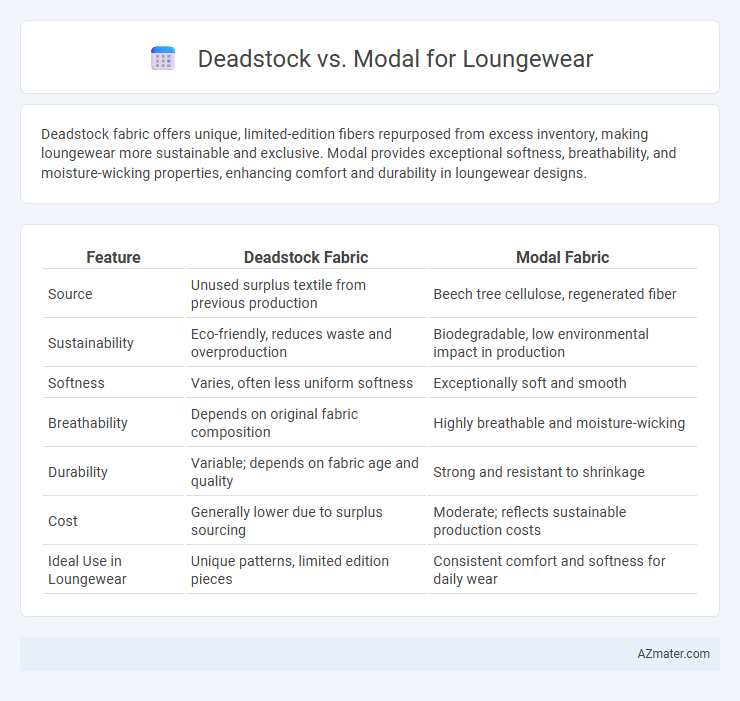Deadstock fabric offers unique, limited-edition fibers repurposed from excess inventory, making loungewear more sustainable and exclusive. Modal provides exceptional softness, breathability, and moisture-wicking properties, enhancing comfort and durability in loungewear designs.
Table of Comparison
| Feature | Deadstock Fabric | Modal Fabric |
|---|---|---|
| Source | Unused surplus textile from previous production | Beech tree cellulose, regenerated fiber |
| Sustainability | Eco-friendly, reduces waste and overproduction | Biodegradable, low environmental impact in production |
| Softness | Varies, often less uniform softness | Exceptionally soft and smooth |
| Breathability | Depends on original fabric composition | Highly breathable and moisture-wicking |
| Durability | Variable; depends on fabric age and quality | Strong and resistant to shrinkage |
| Cost | Generally lower due to surplus sourcing | Moderate; reflects sustainable production costs |
| Ideal Use in Loungewear | Unique patterns, limited edition pieces | Consistent comfort and softness for daily wear |
Introduction: Understanding Deadstock and Modal Fabrics
Deadstock fabric consists of unused, leftover textile inventory from previous production runs, offering sustainable and unique material choices for loungewear. Modal, a type of rayon made from beech tree pulp, is prized for its softness, breathability, and moisture-wicking properties that enhance comfort. Comparing deadstock and modal fabrics highlights sustainability benefits versus performance attributes crucial for comfortable and eco-friendly loungewear.
What is Deadstock Fabric?
Deadstock fabric refers to unused, surplus textile material originally produced for previous fashion seasons or manufacturing runs that remain unsold or unused. It is highly valued in loungewear for its sustainability benefits, as repurposing deadstock reduces fabric waste and environmental impact. Designers often choose deadstock for its unique textures and patterns, providing exclusive, eco-friendly options compared to newer, mass-produced modal fabrics.
What is Modal Fabric?
Modal fabric is a type of semi-synthetic cellulose fiber made from beech tree pulp known for its softness, breathability, and moisture-wicking properties, making it ideal for loungewear. Its smooth texture and excellent drape enhance comfort, while being more resistant to shrinkage and pilling compared to traditional cotton. Modal is often favored in sustainable fashion due to its eco-friendly production process and biodegradability, distinguishing it from deadstock fabrics, which are repurposed leftover materials from other collections.
Sustainability Comparison: Deadstock vs Modal
Deadstock fabric repurposes surplus materials, significantly reducing textile waste and minimizing environmental impact compared to conventional production methods. Modal, derived from sustainable beechwood pulp, offers biodegradability and low water consumption but involves chemical processing that can affect its eco-friendliness. Choosing deadstock for loungewear prioritizes waste reduction and carbon footprint minimization, while modal emphasizes renewable raw materials and biodegradability, making both fabrics viable sustainable options depending on production practices.
Comfort and Feel: Which is Softer for Loungewear?
Deadstock fabric often offers a unique, vintage softness due to its age and previous storage conditions, giving loungewear a distinct, broken-in feel. Modal, a semi-synthetic fabric made from beech tree pulp, is renowned for its exceptionally smooth and silky texture, providing superior softness and breathability. For loungewear prioritizing softness and comfort, modal generally outperforms deadstock fabrics, delivering a consistently plush and lightweight feel against the skin.
Durability of Deadstock vs Modal in Everyday Wear
Deadstock fabric, sourced from surplus or unused materials, offers exceptional durability due to its original manufacturing quality and dense weave, making it ideal for long-lasting loungewear in everyday use. Modal, a type of semi-synthetic rayon derived from beech tree pulp, provides softness and breathability but tends to be less durable than deadstock, showing signs of wear such as pilling and thinning faster under constant use. The inherent strength and density of deadstock fabrics ensure superior resistance to abrasion and stretching, supporting sustained comfort and appearance over time compared to modal blends.
Style and Aesthetic Differences
Deadstock fabric offers unique, vintage-inspired patterns and textures that create a distinctive, one-of-a-kind aesthetic for loungewear, appealing to those who value sustainability and retro style. Modal fabric provides a smooth, luxurious finish with a modern, sleek appearance, enhancing the drape and softness of loungewear for a polished and contemporary look. Choosing between deadstock and modal influences the overall style, where deadstock lends character and individuality, while modal emphasizes comfort and elegance.
Cost Analysis: Price Points for Deadstock and Modal Loungewear
Deadstock loungewear offers lower material costs due to surplus fabric being sold at discounted rates, making it an economical choice for budget-conscious brands. Modal loungewear features a higher price point because of the sustainable production process and the softness of the fabric, reflecting its premium quality. When comparing cost analysis, deadstock is advantageous for reducing material expenses, while modal justifies its expense with durability and consumer appeal.
Ethical Considerations: Environmental and Social Impact
Deadstock fabric repurposes surplus or unused textiles, reducing waste and minimizing environmental impact by preventing additional resource consumption and landfill overflow. Modal, a semi-synthetic fiber derived from beech tree pulp, offers biodegradable qualities and lower water usage compared to conventional cotton, yet its production can involve chemical treatments that require careful management to avoid pollution. Both materials present ethical advantages for loungewear through sustainability efforts, with deadstock prioritizing waste reduction and modal emphasizing renewable sourcing, while social impact depends on responsible manufacturing practices throughout the supply chain.
Which Fabric is Best for Loungewear? Final Verdict
Deadstock fabric offers sustainability benefits by repurposing leftover textiles, ensuring unique patterns and limited availability, while Modal stands out for its softness, breathability, and moisture-wicking properties, making it highly comfortable for loungewear. Modal's smooth texture and durability provide superior comfort during extended wear, whereas Deadstock may vary in quality depending on the source material. For loungewear, Modal is generally the best choice due to its consistent softness, stretchability, and eco-friendly production processes, while Deadstock suits those prioritizing sustainability and exclusivity.

Infographic: Deadstock vs Modal for Loungewear
 azmater.com
azmater.com